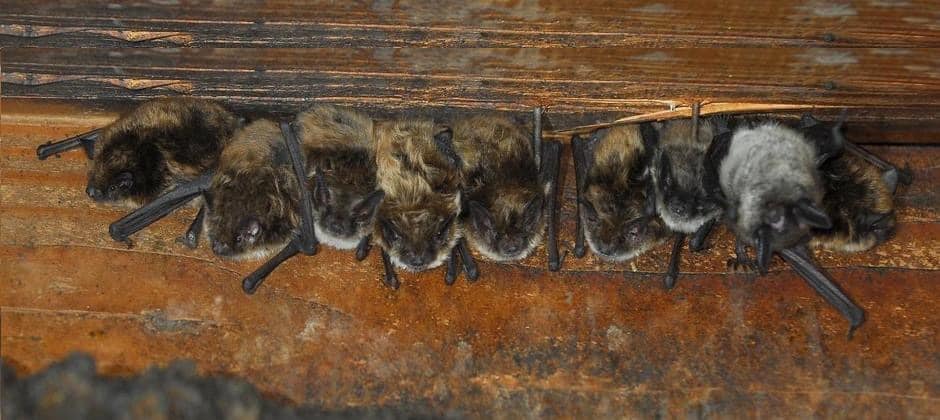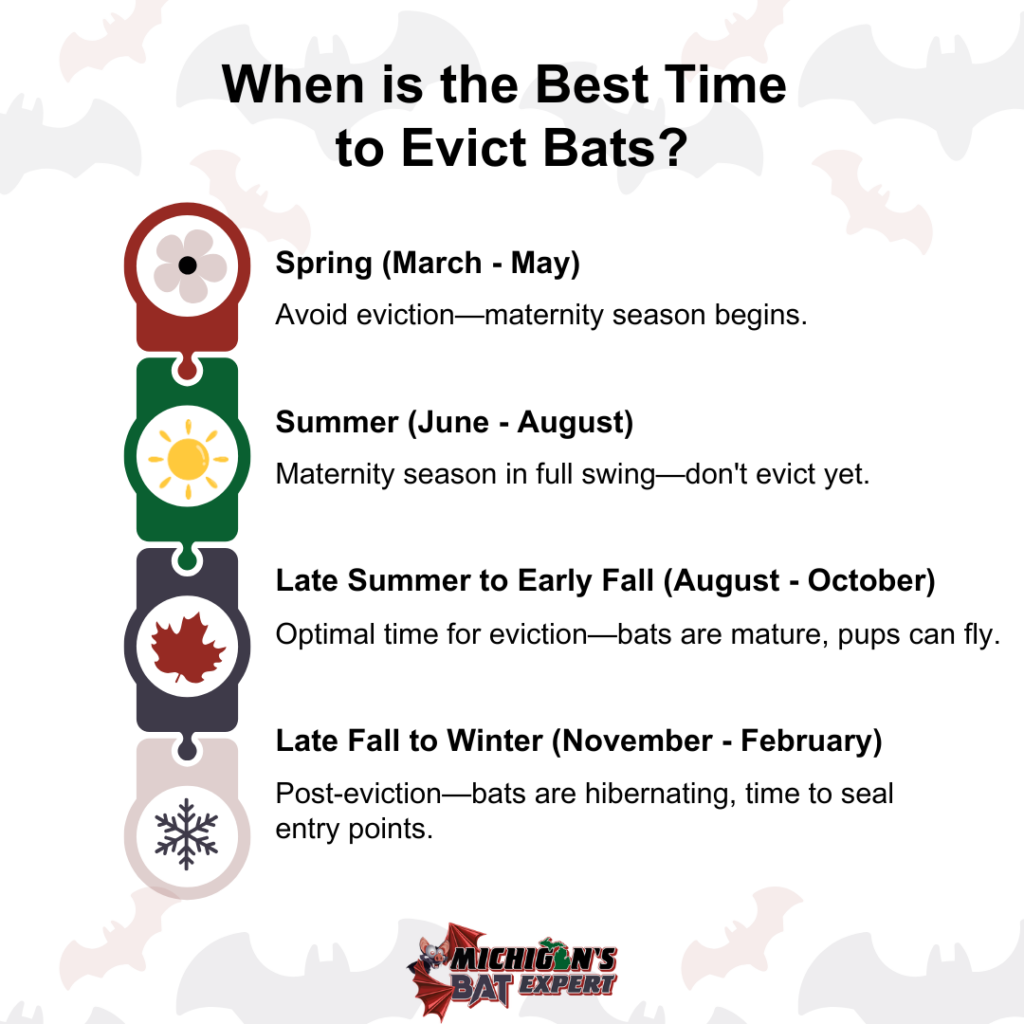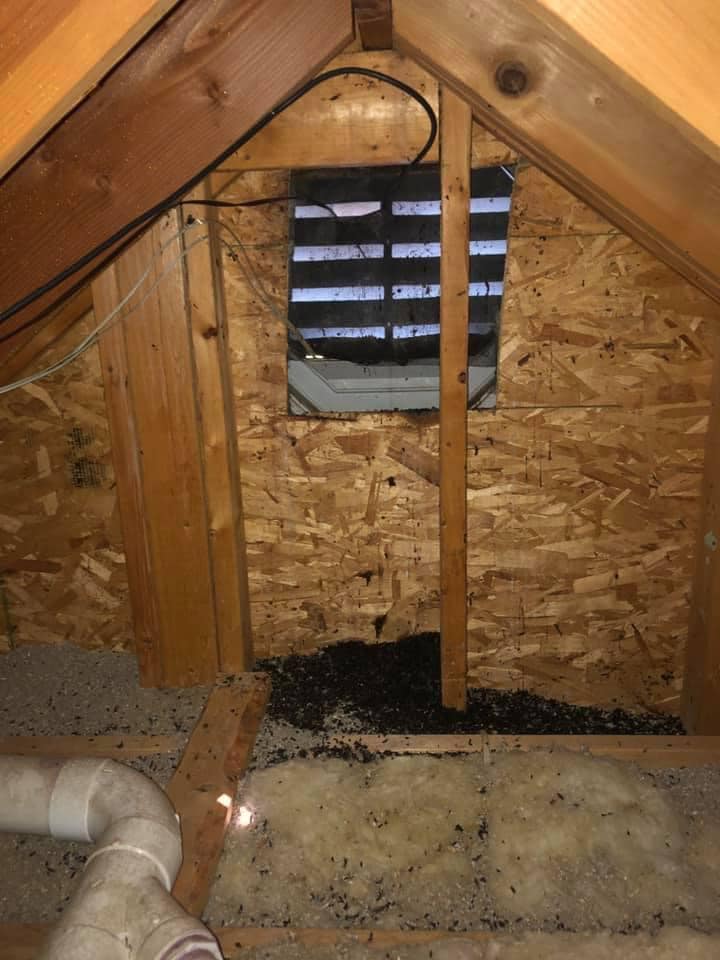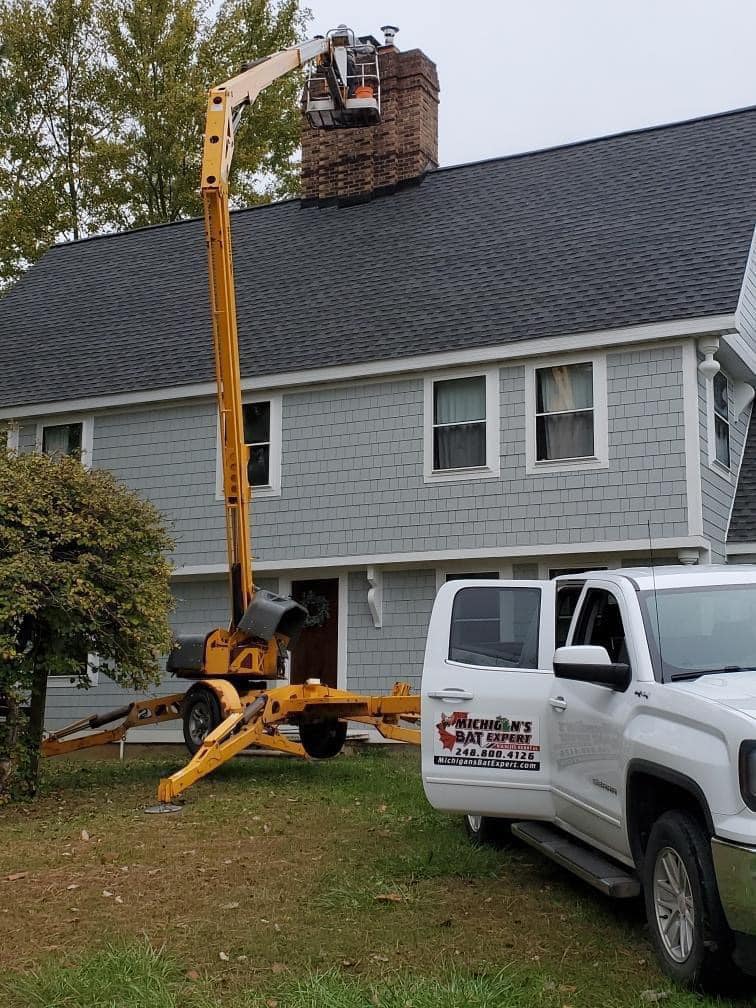
Dealing with bats in your home can feel like a huge challenge, but don’t worry—getting it right and having the right help makes all the difference. Knowing when it’s time to evict bats is essential—not just for your safety, but also for the bats’ well-being. Timing plays a huge role in making the eviction process safe, smooth, and compliant with the law. Evicting them at the wrong time can lead to unnecessary harm for the bats or even create legal problems for homeowners.
In this article, we’ll walk you through how understanding bat behavior, seasonal patterns, and the legal guidelines can help you get it right.

Why Timing Matters for Bat Eviction in Michigan
When it comes to evicting bats from your home, timing is everything. We always say, bat eviction isn’t something that can be done just any time—it requires careful planning. If you act too early or too late, you could risk not only the safety of the bats but also the safety of your home and family.
Bats go through different phases throughout the year, like maternity season or hibernation, and knowing when these occur is crucial to making sure your eviction is both effective and humane. Evicting bats at the wrong time can cause harm to the young bats, disrupt their natural behavior, and, worst of all, can even violate local wildlife protection laws.

Maternity season considerations
If you’re wondering when it’s safe to remove bats, the maternity season is one of the most important times to consider. From May to August, female bats give birth to their pups, and this is a critical period when eviction should be avoided. You see, baby bats can’t fly in the early stages of their lives, so evicting them during maternity season could leave the pups behind.
This would not only cause harm to the young bats but would also break legal regulations designed to protect wildlife. In Michigan, bats are a protected species, and eviction during maternity season is strictly regulated.
That’s why, when working with professionals like us, we always ensure that the pups are mature enough to leave their roosts with their mothers before we take any action.
Post-maternity season eviction
Once maternity season ends and the pups have matured, late summer to early fall is typically the best time for bat eviction. By this point, the pups are fully developed, capable of flying, and no longer dependent on their mothers. This makes the eviction process much easier and safer.
When eviction occurs after August, the bats leave their roosts on their own, reducing the likelihood of traps or complications. This is the time when bat exclusion becomes a much simpler process, as there are no worries about separating mother bats from their pups.
The Bat Exclusion Process: Timing and Bat Behavior
Now that we’ve established when to act, let’s talk about how we make sure the process is both humane and effective. Here’s how we tackle each step of the bat eviction process:
- Inspect your home (timing impact):
The best time to inspect your home for bat activity is during peak bat activity months—late summer to fall. This is when bats are leaving their roosts to forage, making it easier to identify entry points and signs of bat activity. Look out for bat droppings (guano), as these are telltale signs that bats are roosting in your attic, chimney, or walls. - Install one-way exclusion devices (optimal timing):
Installing one-way exclusion devices is a crucial step in ensuring that bats leave your home but can’t get back in. We recommend doing this when bats are most active, usually in late summer to early fall. The key is to install the devices just before dusk when the bats are getting ready to leave for the evening, ensuring they can exit without being trapped. - Seal entry points (post-exclusion timing):
Once the bats have left, it’s time to seal any potential entry points. Timing here is key. Sealing cracks and gaps should be done after all bats have exited to prevent them from re-entering. Late fall to early winter is a good time for sealing, as the bats have already vacated their roost for hibernation. Sealing entry points at this time ensures your home stays bat-free.
By focusing on the timing of each step, we make sure that the entire eviction process is both humane and effective.

Legal Considerations for Bat Eviction in Michigan
Bats in Michigan are protected by both state and federal laws, which regulate their removal and ensure humane treatment. It is illegal to harm or kill bats, especially during maternity season, and eviction must be carried out in a way that avoids disrupting the bats’ natural behavior.
During the maternity season, eviction is prohibited to protect the pups. If you attempt to remove bats during this period without proper permits or methods, you could face fines or legal issues. Working with bat specialists ensures that your eviction complies with Michigan’s wildlife protection laws.
For more information on the legality of bat removal, refer to our article on Is it Illegal to Kill Bats in Michigan?.
Why Choose Professionals for Bat Removal?
When it comes to evicting bats from your home, it’s not just about getting them out—it’s about handling the process the right way. Sure, DIY methods might seem tempting, but working with professionals means you’re ensuring the process is safe, humane, and effective. We know bats well—they’re tricky little creatures, and getting rid of them properly requires experience, knowledge, and the right tools.
So, why are experts the way to go? Well, here’s why:
- Expertise: Professionals understand bat behavior and know the best practices for exclusion. They also follow local regulations to ensure everything is handled correctly.
- Compliance: The eviction process must be legal and humane. Professionals ensure that every step is compliant, preventing any issues with local laws or animal protection.
- Prevention: Once the bats are safely removed, professionals seal any entry points to prevent future infestations, offering a permanent solution to the problem.
And, just to show how this approach works, here’s what Janet, one of our satisfied customers, had to say:
“They did a great job encouraging the bats to leave our chimney and not return. Highly recommend!”

This article is part of our ongoing effort to help Michigan homeowners with safe and humane bat removal. Stay tuned to our blog for more tips and expert advice—we’ll be posting useful content regularly!
Schedule Your Professional Bat Eviction Today
Timing, humane methods, and professional expertise are crucial when it comes to bat eviction. Understanding the best times to evict bats and relying on bat specialists ensures a safe, legal, and effective removal process.
If you’re dealing with bats in your home, contact our expert team today for a thorough inspection and exclusion process. Our professional Michigan bat removal services are available year-round to ensure your home remains bat-free.

Sam Sullivan is the owner and lead expert at Michigan’s Bat Expert, specializing in humane bat removal and exclusion services based in Oakland County, Michigan. With years of hands-on experience in wildlife control, Sam has helped countless homeowners and businesses protect their properties from bat and wildlife infestations while adhering to Michigan’s strict wildlife laws.
His expertise lies in exclusion and prevention, ensuring that bats and wildlife are removed safely and never return. Sam is dedicated to ethical and effective solutions, using proven methods that prioritize both property protection and wildlife conservation. His commitment to excellence has made Michigan’s Bat Expert a trusted name in the industry.


